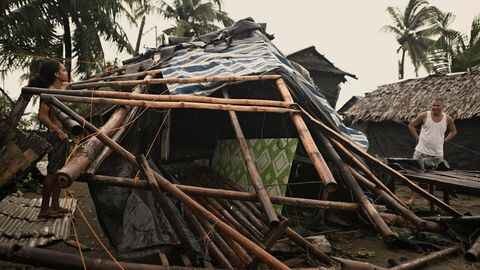In the northern town of Ambaguio in the province of Nueva Vizcaya, a landslide caused by Man-yi’s torrential rains and ferocious wind buried a house and killed at least seven people.
Before it blew away from the northern Philippines, Typhoon Man-yi wrecked houses, uprooted a huge number of villages, and caused a landslide that killed at least seven people, officials said, exacerbating the problem caused by many back-to-back storms.
According to regional police chief Brig. Gen. Antonio P. Marallag Jr., Man-yi’s torrential rains and strong winds caused a landslide early Monday in the northern town of Ambaguio in Nueva Vizcaya province, burying a house and killing seven people—including children—and injuring three more.
According to Marallag, three more persons were thought to have been buried in the avalanche of mud, stones, and uprooted trees, and army forces, police, and villagers were frantically searching for them.
When Man-yi struck the eastern island province of Catanduanes on Saturday night, it had sustained gusts of up to 195 kilometers (125 miles) per hour, making it one of the strongest of the six major storms to batter the northern Philippines in less than a month.
US Defense Secretary Lloyd Austin announced an additional $1 million in humanitarian relief for storm victims while meeting with President Ferdinand Marcos Jr. in Manila and offering his prayers. He informed Marcos that he had given US troops permission to assist Filipino forces in delivering life-saving assistance.
In order to add the two villagers who died in a motorcycle accident and electrocution to the total number of fatalities, disaster response officials stated they were investigating whether the deaths were directly connected to Man-yi’s onslaught.
A couple and their child were the subject of a separate search, they alleged, after their slum was washed away by raging waters in the northern province of Nueva Ecija.
“The worst situation”
According to the Official of Civil Defense, the typhoon and two prior storms affected over a million people, including about 700,000 who had to leave their houses and relocate to emergency shelters or relatives’ homes.
According to the report, over 100 cities and towns experienced power outages as a result of fell electric posts, and about 8,000 homes were damaged or destroyed.
According to provincial information officer Camille Gianan, officials in the hardest-hit province of Camarines begged for further assistance after strong winds and rain destroyed more homes and shut off the region’s water and electricity supply as well as mobile connections in numerous locations.
According to Gianan, welfare workers brought food aid, drinking water, and other supplies, but more will be required in the upcoming months. To restore their homes, many villages would require building supplies, she added.
“When the super typhoon struck, they hadn’t recovered from the prior storms,” Gianan stated. “It’s been disaster after disaster.”
More than 160 people were killed and 9 million were impacted by the unusually high number of back-to-back storms and typhoons that pounded Luzon, the largest and most populated island in the Philippines, in just three weeks. The damage to communities, infrastructure, and farmlands was so severe that the country may have to import more rice, a staple food.
Marcos instructed his Cabinet and provincial authorities to prepare for “the worst-case scenario” during an emergency meeting as Man-yi drew near.
Due to strong waves, thousands of commuters and travelers were left stranded as at least 26 domestic airports and two international airports were temporarily closed, and inter-island ferry and freight services were discontinued. According to the Philippine Civil Aviation Authority and the Coast Guard, the majority of transportation services have now resumed.






